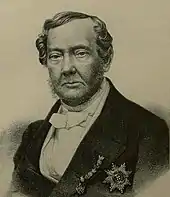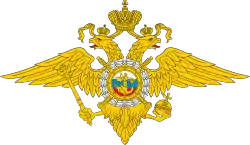Sergey Stepanovich Lanskoy
Sergey Stepanovich Lanskoy (Russian: Сергей Степанович Ланской; 3 January 1788 [O.S. 23 December 1787] - 7 February [O.S. 26 January] 1862) was the Russian Minister of the Interior from 1855 to 1861, being inaugurated during a reform-minded era and dismissed after the Emancipation Reform of 1861. He is known for being close friends with Nikolay Milyutin, who drafted the Russian Emancipation proclamation, and with his brother, Dmitry Milyutin, who was serving as Minister of War.[1]

Political career
In 1810, Lanskoy had joined a Freemason lodge, and held important positions until the closing decree of 1822. After this, he was a member of the Union of Prosperity, but was out of it by the disturbances of 1825. His last known secret organization was the Theoretical Degree of the Order of the Golden-Rose Cross, which also remained clandestine throughout his life.[2] He was known particularly for being with the Freemasons and for being "with the Brothers" (the Milyutins) in Russian society.[1] In this regard, he has also been connected multiple-times with Leo Tolstoy and other Russian Liberals and Constitutionalists who had been involved in Masonic lodges.[3]
In the early 1850s, around 1852, Lanskoy had been involved with the reformation of the Russian prison system. He had rejected donations to the prison system for prisoners, until prisoner committees could be established, and then finally gave into the plan for a Krasnoyarsk Prisoners Society, to serve this purpose.[4]
In 1855, Lanskoy was behind an initiative to tell Europe about Russia in liberal and progressive hues, establishing Le Nord as a newspaper in Belgium to give air to these views.[5]
During a meeting of nobles in 1856, Lanskoy tried to persuade a group of nobles to voluntarily abolish serfdom, because "it would be in their interests to grant the serfs emancipation before the peasants rebelled..." (which is what actually happened)[6]
When Milyutin finally authored the Emancipation Proclamation for Russian serfs in 1861, just a year before Lanskoy's death, Lanksoy's place was considered important. Being born in the 1700s and having a prestigious military career, he "was the only representative of an earlier generation of Russian civil cervants."[7]
References
- Aries: Journal for the Study Or Western Esotericism, Volumes 3-4. Brill. 2003. p. 60.
- Raffaella Faggionato (2006). A Rosicrucian Utopia in Eighteenth-Century Russia: The Masonic Circle of N.I. Novikov. Springer Science & Business Media. p. 260. ISBN 9781402034879.
- Inessa Medzhibovskaya (2018). Tolstoy and His Problems: Views from the Twenty-First Century. Northwestern University Press. ISBN 9780810138827.
- Andrew A. Gentes (2010). Exile, Murder and Madness in Siberia, 1823-61. Springer. p. 194. ISBN 9780230297661.
- Adrian Brisku (2017). Political Reform in the Ottoman and Russian Empires: A Comparative Approach. Bloomsbury Publishing. ISBN 9781474238533.
- Sheila Jones (1966). A student's history of Russia. Pergamon Press.
- Daniel T. Orlovsky (1981). The Limits of Reform: The Ministry of Internal Affairs in Imperial Russia, 1802-1881. Harvard University Press. p. 52. ISBN 9780674534353.

